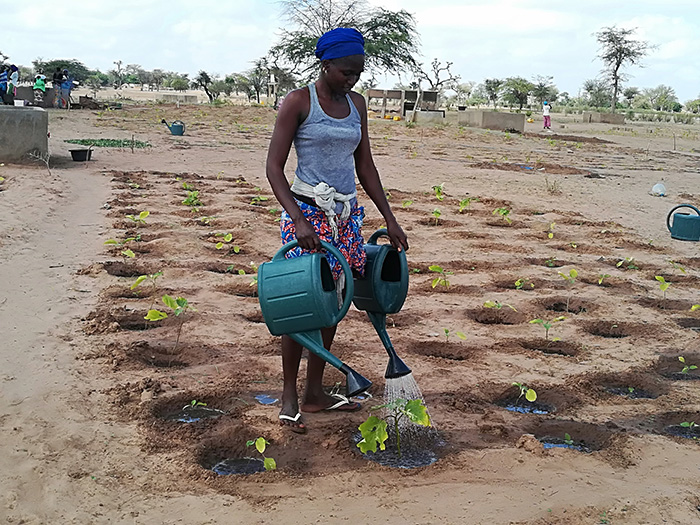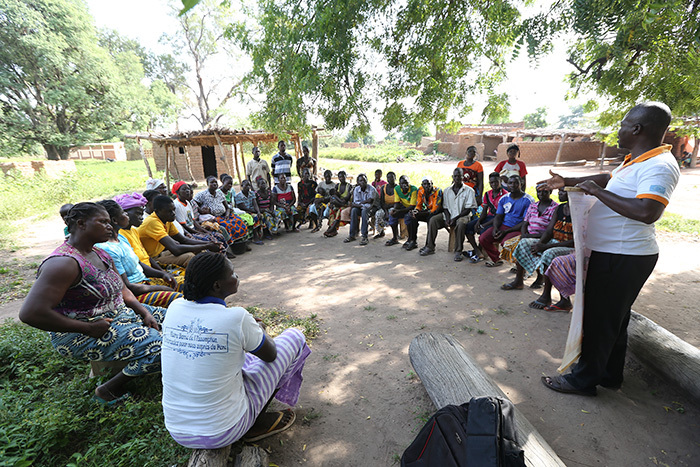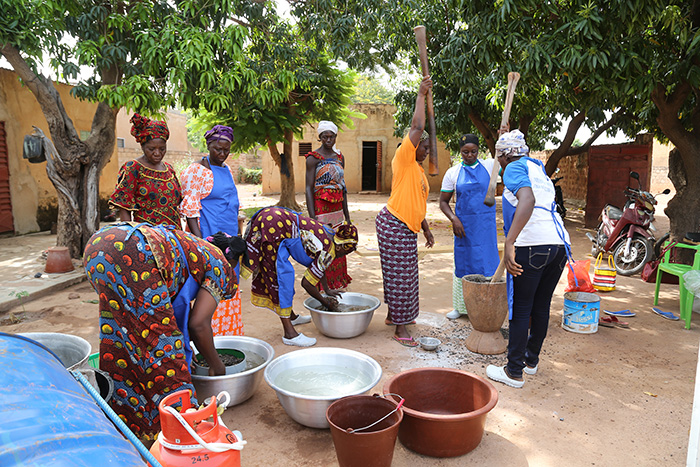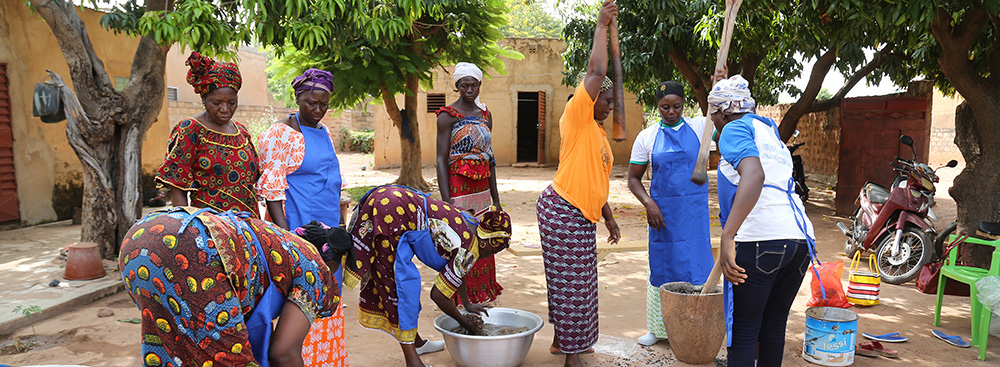The number of people suffering from food insecurity is constantly increasing and the Covid-19 pandemic has exacerbated this phenomenon and exposed the shortcomings of our food systems. Since 2018, GRET has been conducting collective reflection on gateways that can be established between agriculture and nutrition for sustainable food security.
Since 2018, the Asanao programme, developed by GRET and its partners with the support of Agence française de développement (AFD), the European Union and Monegasque Cooperation for development, has been contributing to improving the food and nutrition security of populations in five West African countries: Burkina Faso, Guinea, Mauritania, Niger and Senegal. It focuses in particular on better coordination between coverage of different family members’ food needs on the one hand, and on an increase and sustainability of their income and production on the other hand. It is in this context that GRET is also working in favour of healthier, more sustainable food systems to improve households’ food environments. This can be achieved in particular via support for public policies favouring the emergence of value chains valorising diversified local produce, improved physical access to healthy foods and strengthening of information and consumers’ knowledge on the nutritional value of foods and the importance of a balanced diet.
During the first phase of the programme (2018-2021), GRET conducted collective reflection on gateways to be established between agriculture and nutrition. This reflection focused on carrying out integrated diagnoses, capitalisation on actions conducted, strengthening of its teams’ and partners’ capacities (farmer’ organisations, interprofessional organisations, small food processing businesses, etc.), and on on the preparation of new projects in West Africa and other zones (Haiti, Madagascar, South-East Asia). Four webinars were organised at the start of 2021 to share findings and today it is possible to summarise the programme’s first three years of implementation.
Decompartmentalising knowledge and developing synergies for nutrition
Nutrition diagnoses conducted locally in the first months of the programme raised various issues. They pointed to the difficulty of obtaining reliable indicators at territorial level to ascertain inhabitants’ food and nutritional situation in this zone. Some indicators are only available at national level and do not enable detection of disparities at local level, for example in Senegal, where data on cereal production is only available at departmental level. To address this problem, the programme teams insisted on identification of the stakeholders present, their interest, skills and capacities for working on nutrition. This also makes it possible to have an overview of the local situation and to co-construct a long-term strategy for action rooted in the territory.
Diagnoses on nutrition also highlight problems sometimes not related to the scope of action of the project or the local authority, such as lack of physical access to markets or lack of access to healthcare. These issues require broader action by the State and local authorities. It is important therefore to have exchange platforms or frameworks for consultation making it possible to favour decompartmentalization of actions in the various sectors, at departmental or regional level, so that certain actions within these territorial levels can be undertaken.

In addition, the actions conducted demonstrated the importance of working on tools dedicated to the links between agriculture and nutrition, based on the seasonal calendar of production activities and marketing of produce, and organising discussion on the food and nutritional impacts of certain family choices at different stages in the year. These tools are often rare, yet they are an important base for discussing determining subjects such as time management, workload and economic management within a family farm. To develop these types of tools and formalise a common language, it is important to support participative approaches involving both farmers’ organisations and healthcare and nutrition stakeholders. The awareness-raising tools proposed must therefore be adapted to the context and accessible to all.
In order to be capable of including nutritional issues in agricultural support and advice services, the teams in the field must be trained in the basic concepts of a balanced diet and nutrition, and on the links between agriculture and nutrition. This concerns facilitators, and on a larger scale partners’ and States’ services. With regards family food issues, promoting sessions of peer discussions in addition to awareness-raising sessions and training is an effective approach. The acquisition of new knowledge and discussions among participants on solutions to common problems make it possible to jointly initiate changes in food practices and choices in terms of how the family farm is run. The attitude of facilitators is essential, both for transfer of knowledge and facilitation of discussions.

The experiences presented highlight the importance of conducting activities to support behavioural change, to complement improvement of knowledge and appropriation of the issues by the target families. Similarly, it is necessary to understand the political, economic or socio-cultural factors that can obstruct improvement of food practices in order to work around these same factors.
The local private sector, a major element in food security
Drawing on existing organisations and dynamics makes it possible to ensure the sustainability of actions undertaken. Local associations supporting farmers’ groups must be involved during planning, implementation and monitoring of activities. Facilitating their contacts with healthcare structures or structures working in other sectors makes it possible to work in a complementary manner on food and health issues, and also on behavioural change over the long term.
In this context, the issue of infant flours became a major subject of reflection. According to the study entitled “The locally produced infant flour value chain in six Sahelian countries”*, conducted as part of the Filao project and produced jointly by GRET, Iram and IRD, global demand for infant flour on the commercial market could reach up to 10,000 tons per year in 2025, i.e. five times more than currently. According to the projections put forward, volumes of local flours distributed via markets are likely to rise to 3,500 tons by 2025, compared to approximately 750 tons today. Supply of raw materials necessary for the manufacture of infant flours is therefore a real opportunity for farmers’ organisations, particularly in terms of securing market outlets.

Currently, due to their poor financial and storage capacities, units producing infant flours tend to purchase supplies from retailers. Purchases are made as needs arise, and the traceability and quality of raw materials cannot be certified. Putting farmers’ organisations and production units in contact with each other to produce infant flours would make it possible not only to ensure stable access to a quality product, it would also open up a stable, remunerative market over the long term. In order for the connection between farmers’ organisations and production units to be successful, the former must be supported with supply of services (access to inputs, support and advice, etc.); capacity-building; implementation of precise, flexible contracts and frameworks for consultation; and equitable remuneration for all stakeholders in the chain. Production units must also be supported to become more structured, forward plan their needs, strengthen their mode of distribution, and develop the promotion of their products to create demand. Capacity building must also be conducted at State level, by laboratories and research institutes, in order to supervise quality and help producers to achieve it. Lastly, local quality infant flours are today in direct competition with less expensive imported products. State structures must therefore work on developing legislation in order to ensure the sustainability of locally produced infant flours, for example by encouraging producers to work towards quality labelling.

Currently, apart from the competition, local flours have a very low level of notoriety and, in some countries, production of infant flours depends largely on institutional markets. To ensure the sustainability of this value chain, communication actions are necessary to facilitate the integration of infant flours in eating habits. States and private businesses also have a role to play because the institutional market alone cannot ensure sustainability of the infant flour value chain.
As part of the second phase of the Asanao programme, launched in April 2021, GRET is aiming to consolidate a food security and nutritional intervention strategy making it possible to strengthen territorial dynamics underway and inform the reflection and intervention strategies implemented by stakeholders in multisectoral structures in the various countries. In the countries where GRET operates, actions will also be conducted to improve the living conditions of 90,000 people. More specifically, the actions rolled out will make it possible to support 15,000 rural households, 70,000 women and 5,000 children, and to strengthen 180 organisations.
*The locally produced infant flour value chain in six Sahelian countries
There has been a worldwide increase in hunger and malnutrition in the world in recent years, with almost 690 million people suffering from chronic food deficiency and 140 million children under the age of 5 suffering from malnutrition. 45 % of child deaths are due to malnutrition, i.e. 3.1 million (FAO, 2019). The Covid-19 crisis accentuated this phenomenon and highlighted the failures of our current food systems and their incapacity to solve the challenges: the number of people suffering from food insecurity and malnutrition in its various forms has been constantly increasing since 2014, while the effects of environmental degradation are increasingly visible (climate change, biodiversity loss, desertification, deforestation, etc.).
The United Nations High Level Panel of Experts (HLPE) on world food security defines food systems as all the elements (environment, people, inputs, processes, infrastructures, institutions, etc.) and activities that relate to the production, processing, distribution, preparation and consumption of food, and the output of these activities, including socio-economic and environmental outcomes”. Working on food systems to make them more sustainable and favourable to nutrition must make it possible to ensure “food nutrition and security for all in such a way that the economic, social and environmental bases to generate food security and nutrition for future generations is not comprised” (HLPE, 2014). This means working on the factors (political, economic, ecological) that determine their environment, on supply chains and their stakeholders to favour agroecological practices, balanced modes of governance within value chains, and on consumers’ behaviour so that they make choices that satisfy the nutritional needs of the various family members, in particular those of children under the age of 5 and pregnant and breastfeeding women.
The content of this article is the sole responsibility of GRET and can in no case be considered as reflecting the opinions of Agence française de développement, the European Union or the government of the Principality of Monaco.



